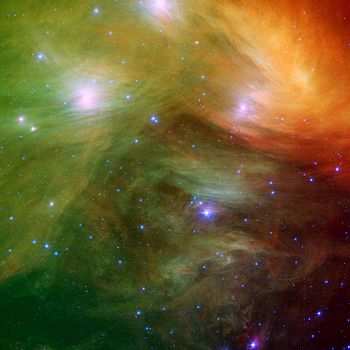- NGC 1435
-
NGC 1435 
The Merope Nebula
and surrounding nebulosity in Pleiades, taken by the Spitzer space telescopeObservation data: J2000 epoch Type Reflection Right ascension 03h 46m[1] Declination +23° 54′[1] Distance 440 light-years (130 parsecs)[2] Apparent magnitude (V) 13 (IC 349)[2] Apparent dimensions (V) 30′[2] Constellation Taurus Physical characteristics Radius 2 ly Absolute magnitude (V) 8 Notable features In Pleiades; contains IC 349 Other designations NGC 1435, Merope Nebula, Tempel's Nebula[2] See also: Diffuse nebula, Lists of nebulae The Merope Nebula (also known as Tempel's Nebula and NGC 1435) is a diffuse reflection nebula, possibly a supernova remnant,[2] in the Pleiades star cluster, surrounding the 4th magnitude star Merope. It was discovered on October 19, 1859 by the German astronomer Wilhelm Tempel. John Herschel, in his New General Catalog (NGC), described it as a very faint nebula about the size of the full moon.
The Merope Nebula has an apparent magnitude starting at 13[2] and quickly dimming by a factor of about 15,[3] making most of the nebula dimmer than magnitude 16. It is illuminated entirely by the star Merope, which is embedded in the nebula. It contains a bright knot, IC 349,[2] about half an arcminute wide near Merope. It appears blue in photographs because of the fine carbon dust spread throughout the cloud. Though it was once thought the Pleiades formed from this and surrounding nebulae, it is now known that the Pleiades nebulosity is caused by a chance encounter with the cloud.
A small and unique nebula which is close to Merope was discovered by Edward Emerson Barnard in November 1890. It is naturally very bright but is almost hidden in the radiance of Merope.[4]
References
- ^ a b "NGC 1435 (Merope Nebula)". SIMBAD Astronomical Database. http://simbad.u-strasbg.fr/simbad/sim-id?Ident=NGC+1435. Retrieved 2011-07-04.
- ^ a b c d e f g "SEDS Students for the Exploration and Development of Space". The star Merope and its Nebula NGC 1435/IC 349 in the Pleiades. http://seds.org/messier/more/m045_merope.html. Retrieved 2007-08-22.
- ^ Herbig, G. H. (1996). "IC 349: Barnard's Merope Nebula". Astronomical Journal 111: 1241. Bibcode 1996AJ....111.1241H. doi:10.1086/117869.
- ^ Merope, Star-Names and their meanings, Richard Hinckley Allen, Dover Publications, 1963, pg. 406.
External links
Categories:- NGC objects
- Pleiades Open Cluster
- Reflection nebulae
Wikimedia Foundation. 2010.

